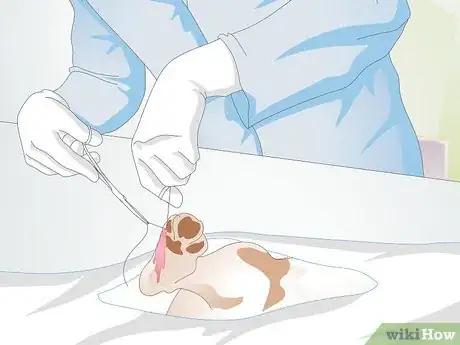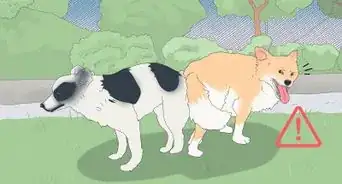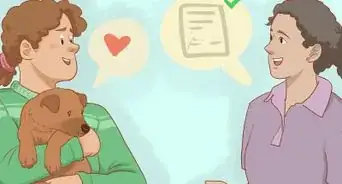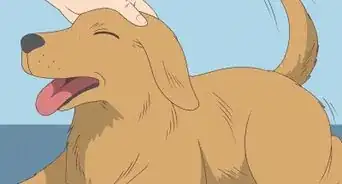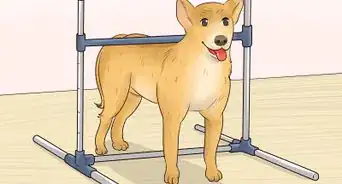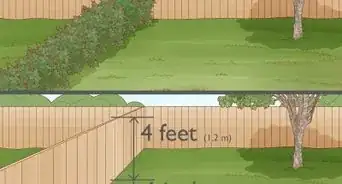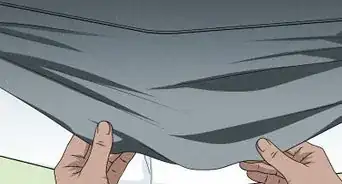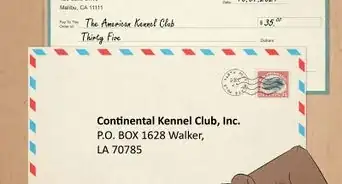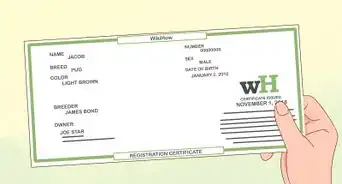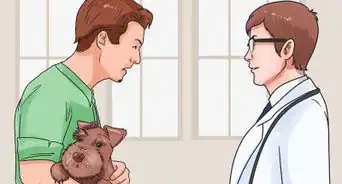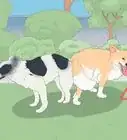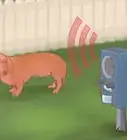This article was co-authored by Melissa Nelson, DVM, PhD. Dr. Nelson is a Veterinarian who specializes in Companion and Large Animal Medicine in Minnesota, where she has over 18 years of experience as a veterinarian in a rural clinic. She received her Doctor of Veterinary Medicine from the University of Minnesota in 1998.
There are 9 references cited in this article, which can be found at the bottom of the page.
This article has been viewed 23,524 times.
Fatty tumors, known as lipomas, are common in middle-aged and older dogs. They are frequently benign, meaning they grow slowly and do not invade nearby tissues or spread throughout the body. Most fatty tumors are just cosmetic problems and don’t need to be removed. However, some fatty tumors can cause real health problems, making surgical removal necessary. If your dog has a fatty tumor requiring removal, get the tumor removed by your vet and take care of your dog after surgery.
Steps
Receiving Veterinary Care
-
1Determine whether tumor removal is necessary. To diagnose a fatty tumor in your dog, your vet will use a small needle and syringe to remove a sample from the tumor and looked at it under a microscope. After the diagnosis, you and your vet will need to decide if the tumor should be removed. Usually, a fatty tumor can be left alone. Below are some reasons why a fatty tumor would need to be removed:
- Tumor is growing rapidly, or growing again after a period of no growth
- Tumor has changed appearance (smooth to lumpy) or texture (soft to hard)
- Body functions are affected by tumor size and location (difficulty walking, breathing, or swallowing) or causing pain (from pressure on the nerves)
- Tumor location (paw, armpit, thigh) makes removal difficult because there may not be enough skin to close the surgical wound
- Dog is bothering the tumor (biting, scratching), potentially causing skin damage and infection
-
2Talk about surgical tumor removal with your vet. Frequently, surgical removal of a fatty tumor is a straightforward procedure. It is unlikely that your vet will encounter problems when removing the tumor. Prior to the surgery, your vet will take a blood sample to ensure your dog is healthy enough for surgery. Below are some questions you can ask your vet about the procedure:
- About how long will the surgery take?
- Will someone contact me after the surgery is over, or if there are problems during surgery?
- Can I pick up my dog on the same day of surgery?
- What care is needed after surgery?
- Do we need to come back to have the sutures or staples removed? If so, when?
- Are there any exercise restrictions (e.g. cage rest, leash walks only, no swimming)?
Advertisement -
3Prepare your dog for surgery. If you and your vet decide on surgical removal, you will need to prepare your dog for surgery. Stop feeding your dog 12 hours before surgery. Also, do not allow your dog to drink water for eight hours before surgery. Your dog should have an empty stomach to prevent vomiting during surgery.[1]
- If your dog vomits during surgery, the vomit could enter the lungs and cause a serious condition called aspiration pneumonia. Aspiration pneumonia requires veterinary treatment.
- Before surgery, make sure your vet is aware of all medications your dog is taking.
- If your dog has a medical condition, ask your veterinarian about any special pre-surgical preparations, especially if your dog has diabetes and takes insulin.
- Your vet will provide you with other pre-surgery instructions, such as when to give your dog vital medications (heart disease medications, insulin) and what time to bring your dog in for surgery.
- Follow all instructions to ensure your dog is prepared for surgery.
- If your veterinarian does not provide you with any guidelines for preparing your dog for surgery, take it upon yourself to ask.
-
4Have your vet surgically remove the fatty tumor. Fatty tumors are usually situated between the skin and underlying muscle, making surgical removal easy. If the fatty tumor is large, there may be a large empty space where the tumor used to be. To prevent this space from filling up with fluid and causing post-surgical problems, your vet may place a surgical drain in that space.
- Surgical drains are typically left in for three to five days.[2]
- Expect your dog to have sutures (either just under the skin or on the skin) or staples that close the incision. Sometimes a pressure wrap or bandage is used to prevent buildup of fluid in the space where the tumor was removed.
Caring for Your Dog After Tumor Removal
-
1Place an Elizabethan collar on your dog. This is very important! Your dog will probably want to lick or chew at the surgical incision. However, doing so could delay healing and possibly infect the wound. An Elizabethan collar, commonly known as an e-collar, will prevent your dog from reaching the incision. Your dog will need to wear the e-collar until it’s time for a follow-up visit with your vet.
- Most e-collars are plastic and shaped like a hood. Others are fabric and not shaped like a hood. Your vet will probably place the e-collar on your dog shortly after surgery.
- E-collars can be awkward for dogs. If your dog is having trouble eating with the e-collar on, consider taking it off during your dog's mealtime. Just make sure you watch your dog to ensure they don't begin licking the wound.
- Plastic e-collars can also get dirty over time. If your dog has a plastic e-collar, wipe the inside of it with a damp cloth when it gets dirty.
-
2Check the incision site. It is normal for a surgical incision to look a little red for a few days after surgery. When you examine the incision, make sure it is clean and that its edges are touching each other. If the incision site is extremely swollen or is continuously bleeding, contact your vet.[3]
- Examine the incision site at least once each day.
- Other than swelling or bleeding, check for green or yellow discharge coming from the incision site. Green or yellow discharge indicates infection. Redness and warmth around the incision site can also indicate infection.
-
3Clean the drain. If your vet inserted a surgical drain, you may need to clean it at home to keep it from clogging. If your vet advises you to clean the drain, do so twice a day. Use a damp cloth to gently clean the drain with warm, slightly salty water (not soap).[4]
- Sometimes, the fluid seeping from the incision can irritate the skin around the drain.[5] Gently clean the skin around the drain with warm, soapy water and a damp cloth.
- Your vet may tell you to just examine the drain without cleaning it.
-
4Administer pain medications as prescribed. After surgery, your dog will probably be in some pain. Your vet will prescribe a few days' worth of pain medication for your dog. The medication will either be in pill form or liquid form.
- If you have to give your dog a pill, try hiding the pill in a tasty treat.
- For liquid pain medication, your vet may either pre-fill the syringes or prescribe the amount that you should draw up into the syringes.
- Place the medication-filled syringe in one of the corners of your dog’s mouth. Once your dog’s mouth opens, gently empty the contents into your dog’s mouth, allowing your dog to swallow the medication.
- If your dog will not take their medicine or if you think the medication is making your dog sick (vomiting, not eating, diarrhea), stop giving it to your dog and call your veterinarian for advice.
-
5Follow your vet's instructions. Carefully following your vet's at-home care instructions will help your dog make a full recovery from surgery. If you are unsure about any of the instructions, such as cleaning around the incision or administering the pain medication, ask your vet to show you the proper technique.
-
6Take your dog back to the vet. A follow-up appointment after the surgery will allow your vet to remove the sutures (and surgical drain, if necessary) and closely examine the surgical site. If you notice any problems with the incision or drain, do not wait until your scheduled follow-up appointment — take your dog to your vet as soon as possible.
- During the follow-up visit, consider asking these questions: Will the fatty tumors come back? Is there any way to prevent more fatty tumors from forming? What should I do if I see more fatty tumors? Does my dog have to keep wearing the e-collar?
Warnings
- Rarely, fatty tumors are malignant, meaning they invade nearby tissues. Malignant tumors are called liposarcomas and are very difficult to completely remove. They are also likely to come back after removal.⧼thumbs_response⧽
- Although most fatty tumors are benign, do not ignore them.[9] Left untreated, they became very large and, depending on their location, affect a dog’s ability to walk, breathe, or swallow.⧼thumbs_response⧽
References
- ↑ http://www.canismajor.com/dog/surgery.html
- ↑ http://todaysveterinarypractice.navc.com/helpful-tips-for-managing-wounds-in-veterinary-patients/
- ↑ http://www.vcahospitals.com/main/pet-health-information/article/animal-health/care-of-surgical-incisions-in-dogs/3768
- ↑ https://www.vetwest.com.au/pet-library/caring-for-your-pet-after-surgery
- ↑ https://www.mspca.org/angell_services/wound-drainage-options-in-veterinary-surgery/
- ↑ http://www.vcahospitals.com/main/pet-health-information/article/animal-health/adipose-lipoma-tumors/124
- ↑ http://www.2ndchance.info/cancer.htm
- ↑ http://onlinelibrary.wiley.com/doi/10.1111/j.1748-5827.2011.01083.x/abstract
- ↑ http://www.merckvetmanual.com/pethealth/dog_disorders_and_diseases/skin_disorders_of_dogs/tumors_of_the_skin_in_dogs.html#v3207573
About This Article
To get fatty tumors removed from your dog, you should take it to your vet for advice about treatment. Often fatty tumors can be left alone, unless they're growing rapidly, have changed appearance or texture, or are limiting your dog's body functions. For example, if the tumor is affecting its ability to walk, breathe, or swallow, your vet might recommend surgery. Don't be afraid to ask questions about the procedure and your dog's after care so you understand exactly what it involves. For more tips from our Veterinary co-author, including how to look after your dog after getting a fatty tumor removed, read on!



